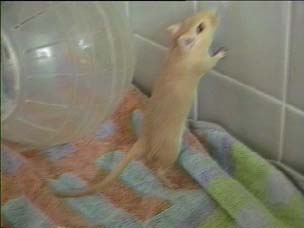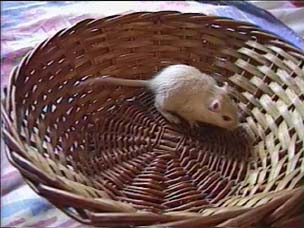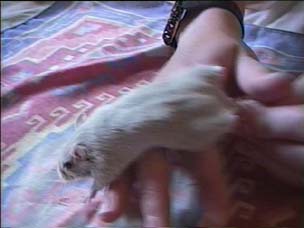The Dani Color Spectrum
I'm trying to collect pictures of every known gerbil color. There are more colors than what I have right here, this is mostly what I have or what my friends have. I hope to add many more pictures in the near future, as one of my pairs will have a number of the colors that I don't have. Click on the pics to see the image big, as the full size took up too much space.
 | Color: Golden Agouti | Genes: A*P*C*G*E* | Distinguishing characteristics: The most common gerbil color, it's usually described as "brown" with a white belly and black eyes. | Example: Danziger is this color. | ||||||||||||||||||||||||||||||||||||||||||||||||||||||||||||
 | Color: Argente golden | Genes: A*ppCCG*E* | Distinguishing characteristics: The body is usually described as "goldish", with a white belly, and they have ruby eyes that look black in some lighting. | Example:Adia is this color. | ||||||||||||||||||||||||||||||||||||||||||||||||||||||||||||
 | Color: Argente cream | Genes: A*ppCc(h)G*E* | Distinguishing characteristics: Just slightly lighter than argente golden and hard to distinguish unless you know the parentage of the animal in question. | Example: Kate bred a cream named Waltz. She now belongs to Beth of DE. | ||||||||||||||||||||||||||||||||||||||||||||||||||||||||||||
 | Color: Black | Genes: aaP*C*G*E* | Distinguishing characteristics: It's black. | Example: Adair is this color. | ||||||||||||||||||||||||||||||||||||||||||||||||||||||||||||
 | Color: Lilac | Genes: aappCCG*E* | Distinguishing characteristics: Usually described as being gray, has ruby eyes that can look black in some lights (as in the picture). Darker than a dove. | Example: Grace was this color | ||||||||||||||||||||||||||||||||||||||||||||||||||||||||||||
 | Color: Dove | Genes: aappCc(h)G*E* | Distinguishing characteristics: A little lighter than lilac. Hard to distinguish unless you know the parentage of the animal in question. | Example:Kate bred a dove named Tango. | ||||||||||||||||||||||||||||||||||||||||||||||||||||||||||||
 | Color: Grey agouti (this one is patched) | Genes:A*P*C*ggE* | Distinguishing Characteristics: It has similar patterns to a normal (golden) agouti, but wherever there would be golden hues on an agouti, there is grey and white. Whereas an agouti would have brown/golden/yellow/black fur, grey agouti would have grey/light grey/white/black. | Example: Riven is this color. | ||||||||||||||||||||||||||||||||||||||||||||||||||||||||||||
 | Color: Slate | Genes: aaP*C*ggE* | Distinguishing Characteristics: Almost exactly like black, but a slightly ligther, bluish hue. Unless you know there are grey agoutis in your area or in the gerbil's bloodline it's best to assume it's black and not slate, as black is more common than slate in North America. (In other areas it could easily be either). | Example: Petit, in the picture, belongs to Mindy. | ||||||||||||||||||||||||||||||||||||||||||||||||||||||||||||
 | Color: Ivory cream | Genes: A*ppC*ggE* | Distinguishing Characteristics: Though hard to see in this picture, ivory creams are a very light yellowy color on top, with a white belly and ruby eyes. They are easily distinguishable from argentes, which have a much more golden coat. The ivory cream's coat is mostly off-white. | Example: Meeshu belongs to Mindy. | ||||||||||||||||||||||||||||||||||||||||||||||||||||||||||||
 | Color:Ruby Eyed White | Genes: aappC*ggE* | Distinguishing Characteristics: REW looks a lot like pink eyed white but is in fact different. Its eyes are "ruby" and not "pink" but the difference is hard to see. REW is said to be "off white" (though it looks mostly white to me). The best thing to do is assume a white gerbil is PEW (or Dark Tailed White) until you can prove otherwise through breeding. In fact I think this is actually a PEW/DTW in the pic but you get the idea ;) | This is Alley from Danziger Litter #1. She now lives with Stephanie. | ||||||||||||||||||||||||||||||||||||||||||||||||||||||||||||
 | Color: pink eyed white | Genes: **ppc(h)c(h)G*E* (PEW) | Distinguishing characteristics: Usually described as "white" or "albino", though there's no such thing as an albino gerbil. PEWs appear to be albino but aren't. | Example:Fox is this color. | ||||||||||||||||||||||||||||||||||||||||||||||||||||||||||||
 | Color: dark tailed white | Genes: P*c(h)c(h) | Distinguishing characteristics: Usually described as "white" or "albino", though there's no such thing as an albino gerbil. DTWs have a dark tail, unlike PEWs, which doesn't usually show until they're a few months old. | Example: This is April's Aurora. | ||||||||||||||||||||||||||||||||||||||||||||||||||||||||||||
 Adult LCPA spot Color:(light) colorpoint agouti | Genes: | A*P*c(b)c(b)E*G* or A*P*c(b)c(h)E*G* Distinguishing Characteristics: CPAs are offwhite with dust on their nose, feet, and ears, with a peppered tail, and nice black eyes. A proposed name for this is "(light) cinnamon pearl" but it's not official. | Example: This is Dakota, a LCPA spot boy, who is April's, and one of Lisa's LCPA girls.
|  Color: burmese | Genes: | aaP*c(b)c(b)E*G* Distinguishing Characteristics: "colorpointed" - comes in two varieties, ultra-dark and normal. Normal has more of a brown middle while UD is kind of a mousy-gray. At about 8 weeks old they develop a black tail, black ears, black fore and hindpaws. Very cute = ) | Example: Gawain belongs to Lisa.
|  Color: siamese | Genes: | aaP*c(b)c(h)E*G* Distinguishing Characteristics: "Colorpointed" - come in two varieties, ultra-dark and normal. Normals have a tan body with dark points. UDs have a gray (almost lilac) body with dark points. See mysteries. | Example: Dana is apparently a UD siamese, as is the pictured Ashwin.
|  Color: light colorpoint nutmeg | Genes: aaP*c(b)c(h)eeG* | Distinguishing Characteristics: It begins looking black eyed white but by about 3 months they have a "dusty" gray smudge on their nose, like a siamese point. Then their tail darkens and starts to look like a grey agouti's tail and they turn a creamy-white color. The effect is like a siamesed cream. | Example: Lilith is this color.
|  Color: sapphire | Genes: | aappCc(b)E*G* Distinguishing Characteristics: Gray with pink/ruby eyes. In appearance, halfway between lilac and dove. Some look more like lilac, others more like dove (this one is closer to lilac, probably). | Example: Gemedet is a sapphire
|  Color: Champagne | Genes: | **P*C*G*e(f)e(f)Spsp Distinguishing Characteristics: Well for one, it's rare. Only in a few areas of the USA will you find these, usually near someone who breed them. It's not uncommon to find them on the west coast or in or around Colorado, though. A Champagne is realy a spotted/pied schimmel (see below) but because of the interaction between Sp and e(f), it is diluted into a black eyed white. Their tails are blackish when they're young, and their ears appear black too, due to the black skin underneath it. Paws can be blackish too. | Example: Reilly is this color.
|  Schimmel age 6 weeks Color: schimmel | Genes: | **P*C*G*e(f)e(f) Distinguishing Characteristics: Orangish at first, with black eyes, and black skin on the paws and on the ears. As they mature, the color fades out to a light apricot. Very pretty. | Example: Eve is this color.
|  Color: Dark Eyed Honey | Genes: A*P*C*G*ee/ee(f) | Distinguishing Characteristics: It's a nice, warm golden color on top, fading off at the sides until you get to the belly, which is white. The eyes are a nice dark brown/black, and very pretty. Looks almost like a young schimmel, but not quite. | Example: Hafwen is this color.
|  8 Weeks Old
Color: nutmeg | Genes: aaP*C*G*ee/ee(f) | Distinguishing Characteristics:They begin life a golden color, with no white belly, and look identical to Dark Eyed Honey if they're patched. They have black eyes and black ears. At about 8 weeks old, like the schimmels, they have a unique molt. But instead of getting lighter, they got lots of gray hairs (ticking) all over, till they turn a mix of brown/yellow/black, almost like a self-colored agouti. | Example: Aether of Danziger litter #3 was nutmeg; so was his grandmother Mindy's Madaline, and my Lucy is a patched.
|  Color: yellow fox | Genes: A*ppC*eeG* | Distinguishing Characteristics: Look just like a dark eyed honey, except with red eyes. They're distinguishable from argentes because they don't have a clear line of demarcation between the belly and the top color, it sort of blends into it. Also like DEHs they have a white circle of fur around the eyes, which attaches to the underbelly color. | Example: This is Symphony owned by Julia (yes she is VERY pregnant)
|  Color: red fox | Genes: aappC*eeG* | Distinguishing Characteristics: It looks much like an argente, but its belly is not as clear-cut. The belly is supposedly "self colored" but to me looks like a light creamy version of the top color. But it's easy to tell from the pure white of an argente's. The eyes are ruby-red and the over all color is orangish-gold. | Example: Lisa breeds red fox
|  Color: polar fox | Genes:A*P*C*eegg | Distinguishing Characteristics: When they're young they look very white at first, then with an offwhite splotch on their back. As they grow they become a creamy-color, and after 8 weeks they start to get light grey ticking about their body. The overall effect is offwhite with some dusting of grey. These are extremely rare in the USA. By the end of 1998 there were maybe two dozen of them in the US. | Example:Mary-Eben is this color.
|  2 wk old Color: silver nutmeg | Genes: aaP*C*eegg | Distinguishing Characteristics: When young, like regular nutmegs, they are orange. However they are a much paler orange than a typical nutmeg. At 8 weeks old they begin to molt silvery fur, and eventually look like a self colored GREY agouti. | Example: Crescendo belonging to Julia, is this color. So was Anthony, belonging to Brian.
| |
Color| Genotype | Credit
| RE silver nutmeg | aappC*eegg
| Apricot | A*ppC*eegg
| Colorpoint slate** | aaP*c(b)c(b)E*gg
| Colorpoint agouti** | ("cinnamon pearl") A*P*c(b)c(b)E*G* | © Gerbil Information Page | Karin van Veen Colorpoint grey agouti** | ("silver pearl") A*P*c(b)c(b)E*G*
| Red eyed schimmel | **ppC*e(f)e(f)G*
| Silver schimmel | **ppC*e(f)e(f)gg
| |
** Colorpoint varieties have "light colorpoint" versions. Example: Colorpoint agouti is A*P*c(b)c(b)E*G* and *light* colorpoint agouti is A*P*c(b)c(h)E*G*.
New Colors
A new gene has just been discovered in Germany. It's the "d" (dilute) gene. At least this is what they think so far. I have no pictures of it, because all of the pictures (there are at least 2) do not belong to me. See The Gerbil Information Page (Colors) for pics. This can be used to create:
A*P*C*E*G*dd - dilute agouti
These are hypothetical colors it could create:
eedd - fawn
BTW thanks for Julian clarifying some of these. At least I think.
Mystery Colors
Dark Patched Pied (NGS page) - Gerbils, when pied, patched, or spotted have a coat color slightly lighter than that of their unspotted counterparts. DPP is when an animal has asymmetrical, irregular spots (usually just one) of the color it would have been were it not spotted. It is most noticable in doves. This has proved difficult to breed in Europe but there is at least one breeder that has some in the US that has no problems with them (a separate mutation?) . Kate Potter, in fact, has a pup she thinks is dark patched pied. Lisa Harrell has also bred one such pup, with TWO dark spots (a dove spot) from a son of Adair & Danziger and a daughter of Adia & Riven.
Ultra-dark colorpoints - Colorpoints in Europe and many in the USA seem to come in two different "shades": normal and ultra-dark ("UD"). These gerbils, when paired to a non-UD mate that will produce burmese or siamese, produce normal colorpoints. For example: UD siamese paired to pink eyed white would produce regular siamese pups. Therefore this phenomenon must not be a dominant gene as originally was thought. Now it appears that most, if not all, of the "UD" gerbils in the USA are actually gg (colorpoint slate, etc.) We're working on gathering evidence to that effect. The same might be the case in the UK--apparently all of theirs are gg too--but they still seem to insist there's something else going on...
Dilute Gerbils - The blues (see above) are no longer really "mysteries" but they are still in need of exploration. Also someone in Germany found a dilute agouti which may somehow be related to the blues. It may well be A*P*C*E*G*dd. Attempts have been made to breed him but so far they have failed.
Hopefully more mystery colors will show up in the future! And hopefully some "mysteries" will be solved.
aaP*C*E*G*dd - blue (real blue)
aaP*C*E*ggdd - lighter blue ("slate" blue? ;)
A*P*C*E*ggdd - blue agouti (??)
ddc(b)c(*) - blue-point siamese (?)
ddc(h)c(h) - blue tailed white (?)
ddeec(b)c(b) - another black eyed white (??)
Other fun things!
Gene| Availability
| a | very common
| p | common
| c(h) | common
| Sp | common
| ee | common in some areas
| e(f) | rare except on the west coast and midwest
| g | rare. Seen in a few pockets along the east coast
| c(b) | rare
| d | nonexistant
| |
 |  |  |






